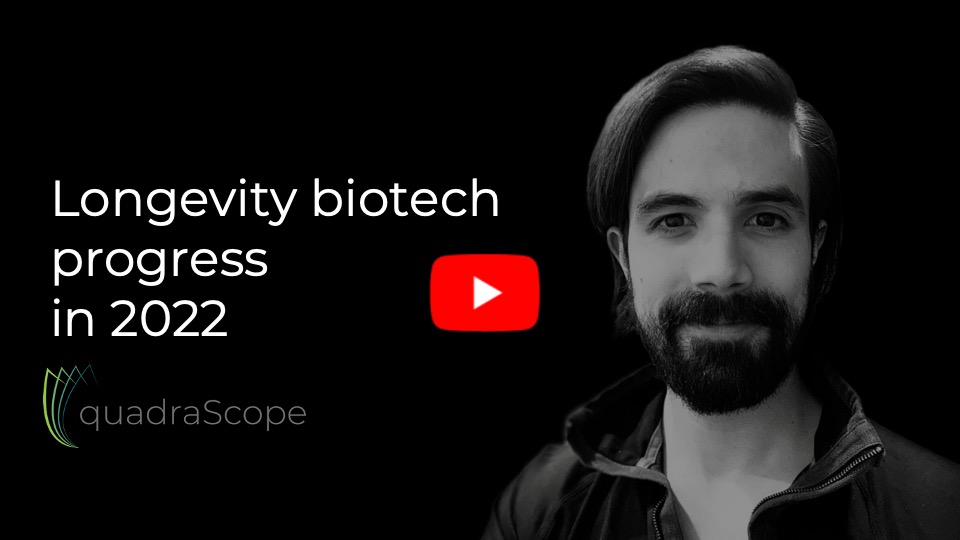Longevity biotech progress in 2022
Despite the economic challenges of 2022, the emerging longevity biotech industry made impressive progress on several fronts, including positive results in clinical trials of senolytics and mitochondrial replacement therapies.
Contents
Unity succeeds at preventing blindness through senolytic therapy
Restoring energy production through mitochondrial transplantation proved feasible
Milestones reached in treatments to clear cholesterol buildup
Progress demonstrated in cellular reprogramming for rejuvenation
Next generation gene editing to treat cancer and hypercholesterolemia in human studies
New methods to catch cancer in very early stages
Existing drugs for longevity treatments to be investigated by non-profits
Breaking the FDA barriers for longevity medicine
New hallmarks of aging introduced
Saudi billions to support longevity – where’s the money going?
Unity succeeds at preventing blindness through a novel senolytic therapy
Senolytics are entering human trials to treat various age-related deteriorations. Unity Biotechnology, backed by billionaires Jeff Bezos and Peter Thiel, reported positive results from a multicenter randomized clinical trial of a new senolytic drug to treat diabetic macular edema, a common cause of blindness in diabetic patients.
Several companies, including Deciduous Therapeutics, Oisin Biotechnologies, and Cleara Biotech, are developing senolytic therapies to treat debilitating chronic conditions such as pulmonary fibrosis, diabetes, and cancer.
Mitochondrial transplantation proved feasible in restoring cellular energy production
Mitochondrial replacement to restore cellular energy production is expected to be highly impactful for age reversal. Minovia, an Israeli biotech company, demonstrated the feasibility of transplanting mitochondria into humans. Although Minovia is treating an illness, their achievement suggests that a similar treatment could be used to enhance healthspan. In Minovia’s clinical trial, children with single large-scale mitochondrial DNA deletion syndromes, a class of severe congenital mitochondrial diseases, received healthy mitochondria from their mothers. The benefits of the therapy were still evident one year after the transplant (Science Translational Medicine, 2022).
Multiple startups are working on treatments to restore or replace aging mitochondria, including Mitrix Bio, Cellvie, Stealth BioTherapeutics, and Yuva Biosciences.
Milestones reached in treatments to clear cholesterol buildup
As people age, cholesterol builds up in the body and can lead to deadly diseases, such as atherosclerosis and NASH (non-alcoholic steatohepatitis). Cyclarity Therapeutics, a SENS Foundation spinout, developed a medication that targets and removes oxidized cholesterol. The company plans to begin clinical trials in the UK in 2023, taking advantage of the Innovative Licensing and Access Pathway (ILAP), a new regulatory pathway to accelerate drug development.
Repair Biotechnologies, a quadraScope portfolio company working on cell therapy and mRNA therapy to degrade cholesterol, recently reached a milestone and is ready to hold a pre-IND (investigational new drug) meeting with FDA officials, the initial step on the road to clinical trials.
Progress demonstrated in cellular reprogramming for rejuvenation
If proven feasible, cellular reprogramming could restore cell health and resilience, and treat diseases and disabilities caused by aging. 2021 and 2022 were the setup years for reprogramming with billions in funding and several ventures started.
Ventures working on reprogramming include Altos Labs, NewLimit, Calico, Life Biosciences, Rejuvenate Bio, and Turn Biotechnologies. Altos Labs scientist Dr. Reik developed a method to reprogram cells, reversing their biological age by 30 years (Elife, 2022). Another Altos Labs scientist, Dr. Izpisua Belmonte, showed that long-term reprogramming was safe and could reverse age-related organ damage in mice (Nature Aging, 2022). His group also developed an RNA-based therapy to reverse biological age and reduce inflammation in mice (Science Translational Medicine, 2022). According to a recent press release, Turn Biotechnologies used a reprogramming mRNA cocktail to rejuvenate human skin cells, increasing cell division and collagen production. In a recent preprint, Rejuvenate Bio reported the development of a cellular reprogramming AAV gene therapy that extended the remaining lifespan of naturally aged mice by 109%.
Dr. David Sinclair invented a mouse model that helps understand the role of epigenetics in aging, thus accelerating the development of longevity treatments based on epigenetic reprogramming (Cell, 2023).
The next generation of gene editing
Base editing, a high-precision gene editing method, has begun clinical trials in 2022 and may offer new alternatives to implement gene therapy for healthspan extension. Compared to traditional CRISPR-Cas9 systems, base editing is safer and more precise because it does not require breaking both DNA strands and can modify single letters of the genetic code.
In May 2022, a research group at University College London used base editing for the first time to generate off-the-shelf CAR T-cells and induce remission in a patient with relapsed T-cell leukemia. Two months later, Verve Therapeutics dosed the first human with a base editing gene therapy to treat heterozygous familial hypercholesterolemia, a disease exhibiting excessive blood cholesterol. Verve Therapeutics licensed their base editing technology from Beam Therapeutics, a biotech company getting ready to use base editing in a clinical trial evaluating off-the-shelf CAR T-cells in 2023.
Prime editing, another emerging gene editing method, allows more extensive genetic modifications than base editing but is still in preclinical development. Beam Therapeutics licensed prime editing technology from Prime Medicine.
New methods to catch cancer in very early stages
Early detection of cancer dramatically improves the odds and speed of recovery. To detect early-stage cancer, Grail and Guardant Health introduced tests to identify circulating DNA from tumors (Cancer Cell, 2022; American Association for Cancer Research annual meeting, 2022), while Tzar Labs pioneered a test to quantify tumor RNA in circulating stem cells (Stem Cell Reviews and Reports, 2021). A research team in Sweden found a potentially cheaper way to detect cancer by measuring glycosaminoglycans, a specific type of sugar molecules in the blood (PNAS, 2022). Currently, the global market for early cancer screening amounts to roughly $1B and has the potential of further penetrating the entire $130B cancer diagnostics market.
Existing drugs for use in longevity treatments
Commercially available drugs and therapies have the potential to treat aging. However, commercialization of these therapies is unlikely to generate sufficient profit to attract venture capital. For example, metformin, acarbose, fisetin, quercetin, rapamycin, and therapeutic plasma exchange have extended healthspan in animal studies and small clinical trials, but haven’t been confirmed in large randomized clinical trials.
Rapamycin and metformin are off-patent medications that reverse multiple hallmarks of aging and may be useful for rejuvenation of the immune system. Some studies have found that patients who were already taking metformin or rapamycin when they became infected with COVID-19 had a milder form of the disease (Scientific Reports, 2022. Frontiers in Medicine, 2022). Caloric restriction may also rejuvenate the immune system. A recent analysis of the CALERIE (Comprehensive Assessment of Long-Term Effects of Reducing Intake of Energy) trial showed that two years of mild caloric restriction produced significant gains in thymus size in middle-aged adults, an interesting discovery that should be investigated in older adults (Science, 2022).
The FDA recently approved Ferring Pharmaceuticals’ Rebyota, the first fecal microbiota product to prevent the infection of C. difficile (FDA news release, 2022). Since our microbiome changes demonstrably with age, fecal microbiota transplant (FMT) from a younger adult to an older one may be effective as a longevity treatment, and off-the-shelf fecal microbiota products could be used off-label as longevity treatments in clinical trials.
Another approach to treating aging could be a combination of currently available therapies, including senolytics, rapamycin, therapeutic plasma exchange, stem cell therapy, metformin, senolytics and more. Formal structured studies are needed to evaluate these combination therapies.
Given that these treatments are off-patent and widely available, there is little promise of returns for private investors, leaving it up to the philanthropic community to fund these important projects. Non-profits, including Dr. Aubrey de Grey’s new Longevity Escape Velocity Foundation (LEVF) will be undertaking some of this work.
On a related topic, the NIH runs the Interventions Testing Program (ITP) to identify and validate treatments that extend lifespan and healthspan in mice. Unlike for-profit companies, programs like the ITP are known to be transparent and encourage collaboration. ITP offers its partners access to research space and mice colonies.
Breaking the FDA barriers for longevity medicine
Identifying objective biomarkers that capture the effects of aging interventions may help convince the FDA to consider aging as a study endpoint. Currently, the FDA only considers disease treatment as an acceptable endpoint, making it difficult to get FDA approval for longevity treatments without a specific clinical condition. The FAST (Finding Aging biomarkers by Searching existing Trials) initiative addresses this need by analyzing published clinical trials to identify biomarkers to be used as endpoints in future studies on aging.
The TAME (Targeting Aging with Metformin) clinical trial is the first large-scale study to test the effects of metformin on aging and age-related diseases. Unlike traditional clinical trials that focus on a single condition, TAME aims to show that metformin can delay the onset of any one of age-related diseases. The study is led by Dr. Nir Barzilai, the Scientific Director of the American Federation for Aging Research (AFAR) and a member of quadraScope’s advisory board. If successful, the TAME trial will set a precedent for trials evaluating longevity treatments that don’t target a specific disease.
The SuperAgers initiative continues its progress as it studies the genes that contribute to a longer lifespan by building the largest database of centenarian families. The project is a collaboration between the AFAR, Albert Einstein College of Medicine, and Boston University, with Dr. Nir Barzilai participating as a co-investigator.
The Healthy Longevity Medicine Society (HLMS) intends to establish longevity medicine as an independent medical specialty and set clinical standards for longevity treatments. The HLMS council brings together leading experts in longevity from around the world, including Dr. Nir Barzilai.
Expanding the focus of longevity biotech
The seminal paper by Lopez-Otín and colleagues defining the targets of longevity biotechnology companies was expanded to introduce 3 new hallmarks of aging: disabled macroautophagy, chronic inflammation, and dysbiosis (Cell, 2023). These biological processes have been studied by longevity scientists for several years but were recently highlighted as independent hallmarks due to the growing understanding of the biology of aging.
Saudi billions to support longevity – where’s the money going?
The Hevolution Foundation was created in 2021 by a Saudi Royal Decree and is sponsored by the Saudi government. The foundation committed $1B per year to fund longevity research and invest in longevity biotech companies. In 2022, Hevolution awarded $8.5M to fund American Federation for Aging Research New Investigator Awards, $2M to sponsor Longevity Impetus Grants, $2.6M to support geroscience research in Saudi Arabia, and $5M to support grants reviewed by the National Institute on Aging. Publicly announced funding that we can account for amounts to $18.1M, well short of a billion promised. A slow start?


